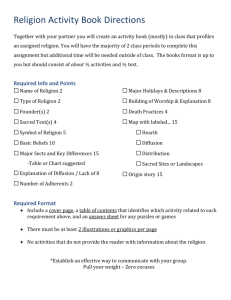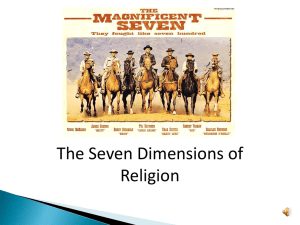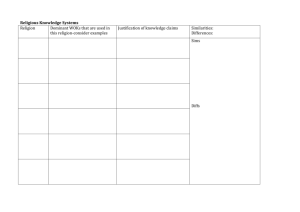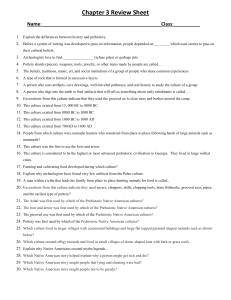CHAPTER TWO: THE SACRED IN NATURE: INDIGENOUS
advertisement
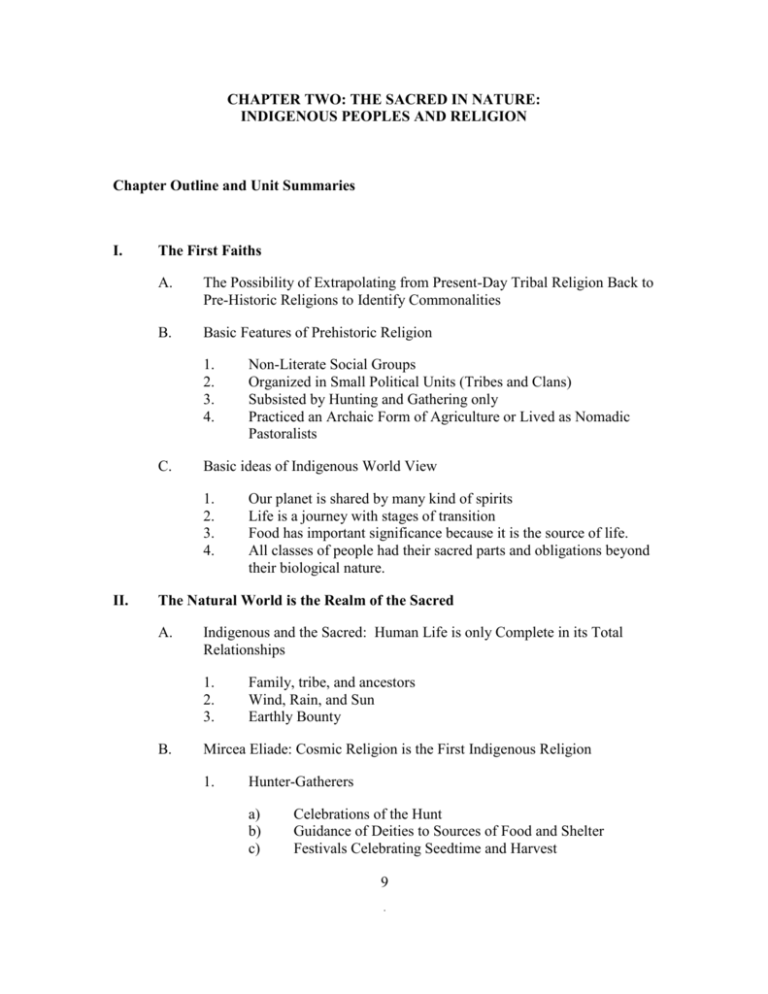
CHAPTER TWO: THE SACRED IN NATURE: INDIGENOUS PEOPLES AND RELIGION Chapter Outline and Unit Summaries I. The First Faiths A. The Possibility of Extrapolating from Present-Day Tribal Religion Back to Pre-Historic Religions to Identify Commonalities B. Basic Features of Prehistoric Religion 1. 2. 3. 4. C. Basic ideas of Indigenous World View 1. 2. 3. 4. II. Non-Literate Social Groups Organized in Small Political Units (Tribes and Clans) Subsisted by Hunting and Gathering only Practiced an Archaic Form of Agriculture or Lived as Nomadic Pastoralists Our planet is shared by many kind of spirits Life is a journey with stages of transition Food has important significance because it is the source of life. All classes of people had their sacred parts and obligations beyond their biological nature. The Natural World is the Realm of the Sacred A. Indigenous and the Sacred: Human Life is only Complete in its Total Relationships 1. 2. 3. B. Family, tribe, and ancestors Wind, Rain, and Sun Earthly Bounty Mircea Eliade: Cosmic Religion is the First Indigenous Religion 1. Hunter-Gatherers a) b) c) Celebrations of the Hunt Guidance of Deities to Sources of Food and Shelter Festivals Celebrating Seedtime and Harvest 9 . d) 2. Shamanism a) b) c) 3. Significant to Indigenous Religion Tells stories of Heroes Reflects rites within tribes Gods, Spirits, and the World A. Images and Myths 1. 2. 3. 4. 5. B. Creation Stories about Beginnings and Where Humans Came from World Made Good, but Something Has Gone Wrong Original/Ultimate Creator High God is a “Deus Otiosus,” Often Uninvolved with Humanity Myths of the Origin of Human Separation from Creator Myths of Lesser Deities Creating World Ancestral Spirits 1. 2. 3. IV. Travel in trance to heaven or the underworld to recover stray or stolen souls Intercede with the Gods Perform to invoke the fundamental sacredness of nature and human beings’ part in it Art, Symbols and Sacred Ideology a) b) c) III. Veneration of Nature Idea of Soul Living Apart from its Dead Body is One of the Oldest Ideas in Religion, Dating Back Thousands of Years Spirits of the Dead Remain Active in World, Particularly Among Family Descendants Some Believe Ancestors Reincarnate in Tribe or Family Initiation Rites of Men and Women A. Life Seen as a Series of Initiations where Cultures Most Meaningful Signs of Status are Bestowed and Deepest Mysteries of the Ultimate Meaning of Human Existence is Revealed. 1. 2. Birth and Death Central Events Requiring Initiation Ceremonial Initiations of Indigenous Cultures Enhance, Ratify, Recapitulate, and Prepare for what is Imparted in Sacred Mysteries of Birth and Death 10 . B. Initiation Rituals for Boys and Girls 1. 2. 3. V. Shamans A. Definition of Shaman: Persons Singled Out by the Divine to Receive Special Ecstatic Powers for Dealing with Spiritual Things 1. 2. B. Shaman Not by Heredity, Apprenticeship, or Appointment Shamans Receive Special Gift/Calling/Testing from Spirit World, Undergo Extremely Traumatic—Even Violent— Psychic and Physical Contacts with the Spirit World The Practices of Shamans 1. 2. 3. 4. VI. Male Circumcision Rituals Mimic Female Menstruation Emphasize Spirits of Nature Working Through Natural Processes of the Human Body Celebrations of that Which Sustains the Tribe as Coextensive with Ultimate Cosmic Reality Shaman Moves Freely Among the Spirit World, Acts as Meeting Point Between Living and the Dead, Guides Souls of the Dead, Intercedes with Them on Behalf of the Living Shaman Performs Semi-spontaneous Dramatic, Suspenseful, Spectacles of His/Her Contacts with the Spirit World and Consequent Psychic and Physical Transformations Some Shamans Make Journeys, Via Séances or Otherwise, into the Spirit World and Report Back to the Living Heal Members of the Tribe/Village from their Spiritual and Physical Maladies, thereby Reinforce Popular Spiritual Lore Tracing Survivals of Archaic Indigenous Peoples’ Religions A. Abrahamic Religions: Contains Elements of Indigenous Religion 1. 2. 3. 4. B. Turn of Seasons The Hunt The Harvest Veneration of the Earth and Sky Popular Religion and American Culture: Altered Version of Archaic Religion 1. Christian Symbolism: Christmas – Winter Solstice 11 . 2. 3. 4. 5. VII. Halloween/All Saint’s Day– Darkest Time of Year When the Spirits are Closest to the Living New Year’s Eve - Precreation Flux New Year’s Day - Recurrent Day of Creation May Day – Beltane, a pre-Christian Spring Festival Indigenous Hunter-Gathers and Agriculturalists A. Indigenous Hunters 1. Symbols of the Divine a) b) c) d) 2. 3. 4. B. IX. Hunting Part of Religious Fabric of Life in Prehistoric Religion Hunting Animals is Act of Interplay with Spiritual Forces Archaic Hunters Relate Soul-to-Soul with Hunted Animal Archaic Hunters Treating Animals with Spiritual Respect 1. 2. VIII. Animal for the Hunter Plant for Agriculturalists King as Giver of Order for Ancient City and Empire Psychological Sense of Self in Relation to Community and the Earth Hunt Rituals The Divine Master/Mistress of Animals Believed to Open or Close the Hunting Area to Humans Indigenous Gathers A. The Archaic Gathers Reveal Reverent Attitude to the Land and Emphasize Interplay of Nature and Spirit World B. Prehistoric Peoples Mostly Dependent on Plant-food and Small Animals, not Large Game C. Women Gather Plant-food and Small Animals, Hence Have High Status in Generally Egalitarian Hunter/Gatherer Societies Indigenous Farmers A. Agriculture had an Awareness that their Craft came after the First Humans and gave a New Importance for the Earth Goddess and Earth’s kin by Gender. B. The Willingness to Plant Seeds and Domesticate Animals Signifies a 12 . Change in Religious Attitude: It is Legitimate to Disturb Nature and Intervene in its Cycles 1. Shift to Agriculture Leads to Change in Religion to Emphasis on Death-Rebirth Symbolism 2. Guilt and Remorse Might Accompany Humans in the “Fall” from Hunter/Gatherer Societies to Agricultural Societies a) b) c) d) 3. The Rise of the Agricultural Death-for-Life Principle a) b) X. Early Agricultural Religions Suggest Guilt Over Lost Innocence of Previous Hunter/Gatherer Life Archaic Myths Contain Themes Suggesting Agriculture Seen as Illicit Act Against Earth The Japanese Myth of Kojiki Equates Murder of Food Goddess and Agriculture The Indonesian Myth of the Hainuwele Equates the Planting of Seeds with Banishing the Divine Creators Agriculture Accentuates Death-for-Life Principle and Takes Form in Preoccupation with Ritual Death Early Agricultural Myths Indicate Sacrificial Killing that Transfers Power from Victim to the Sacrificer The Social Impact of Agriculture, The Role of Women, and The Patriarchical Revolution A. B. C. Beginning of Agricultural Religion, approximately 12,000 years ago, Produced Far Reaching Religion Changes Flourishing Agricultural Economy Supported More Than Farmer, Reaching Traders, Rulers, Priests, and Scholars Religious Products in New Agricultural Economy 1. 2. 3. 4. 5. 6. D. E. Elaborate Polytheism Mirrored in the Heavens the New Division of Labor and Bringing Together of Tribes Subject to Commerce, Taxation, and Control Created a Need for Market Roads and Irrigation Systems. Writing of Sacred Scripture Fruits of Leisure for Priests, Scholars, and Philosophers Huge Impact on the Role of Women in Society Ritual Roles of Girls and Women in the Paleolithic and early Neolithic Societies were Ritually Equal in Religion Complexity of Agricultural Society Became More Hierarchical 13 . 1. 2. 3. 4. XI. Women’s Lives Became More Restricted and Starting to be Subordinate to Men Continued Development of Agriculture Marked Significant and Long-Ranging Reactions by Men Megalithicism was an Important Development in this Society Last Archaic Stage is called “Patriarchal Revolution” Fundamental Features of Indigenous Peoples’ Religions A. Theoretical 1. Basic Worldview a) b) 2. Gold or Ultimate Reality a) b) 3. 4. 5. 6. 7. Myth are told and enacted at festivals or by Shamans Benign Deities and Ancestral Spirits are Helpers Practical: What is Expected of Humans 1. 2. 3. C. Many Deities and Spirits Possible High God or Unifying Force over other Deities and Spirits Either No Point of Origin of the World or the World was created by Gods or a High God who may be Passive. Destiny of the World is not Clear Origin of Humans are Often children of Gods, Gods, or semidivine primal parents Destiny of Humans either goes after Death to Another World or could be reborn in this World Revelation or Mediation between the Ultimate and the Human a) b) B. The universe is a place animated by many spirits Humans have a place in the Order of All Things and are Subject to Rules and Cycles Worship, Practice, Behavior to undergo Initiation Honor and Sacrifice to the Gods and Ancestors Observe Communal Norms of Behavior and Taboos Major Social Institutions 1. 2. Immediate ethnic community is a spiritual unit Shamanism 14 . Key Names, Concepts, and Terms rites shamanism shaman cosmic religion soul popular religion deus otiosus high god taboo Ancestral spirits initiations totem pole ecstasy bodhisattva asceticism Neolithic Paleolithic Mitsimu aboriginal indigenous hunter/gatherers/farmers Mircea Eliade death for life principle Miko matrilineal Patriarchal Revolution megalithism Abrahamic Religions Questions for Class Discussion 1. Prehistoric cosmic religions might seem quite alien to us today. In what ways might features of prehistoric cosmic religions remain a continuing presence in contemporary religious and secular life? First identify some of the authors’ examples. Second, suggest some possible examples from both religious and secular contexts. 2. The authors argue that the “pendulum” swung toward “patriarchy” with the rise of agricultural society, and it might be swinging back toward egalitarian values today. Why do they think the pendulum swung toward patriarchy in the past, and what has changed today that would lead it to swing the other way? Evaluation Questions Multiple Choice 1. Mircea Eliade called the first indigenous religion, including beliefs and practices, a __________ religion. A. patriarchical B. cosmic C. megalithic D. ancestral 2. Halloween, Christmas, and the Muslim pilgrimage to Mecca are contemporary instances of the survivals of elements from _____________: A. an archaic religion B. animism C. shamanism D. totemism 15 . 3. A. B. C. D. 4. The Japanese myth of Kojiki suggests that: __________. archaic Japanese people did not believe in shamans. the development of agriculture in Japan was accompanied by a sense of religious guilt for having violated the earth. women were the dominant hunters in archaic Japanese society. archaic Japanese people originally worshipped a high creator god but then moved to the worship of plants and animals. The ritual practices of the prehistoric and tribal religions, such as the Indian Naga, the Amazonian Jivaro, and the Bengali Khonds all suggest that the __________. A. rise of agriculture was accompanied by the increasingly held belief in the religious value of human sacrifice. B. rise of patriarchy was accompanied by the increasing use of feminine seed- soil/mother-child symbolism. C. decline of cosmic religion was accompanied by the decline of leisure activities such as philosophy and scholarship. D. rise of megalithism was accompanied by the decline of archaic farming. 5. A. B. C. D. The Luguru tribe of East Africa believes __________. in patriarchal social practices. the active involvement of the Creator in their lives. that agriculture leads to a banishing of the gods from human life. the ancestral spirits are concerned with guiding human affairs. True/False 6. It is not possible to extrapolate from present-day tribal religions back to worldwide prehistoric religions because they share no commonalities across historical epochs. 7. Ancient cosmic religions looked to the changing of the seasons, rather than to historical events, as the time when reality is revealed. 8. Initiation rituals emphasize spirits of nature working through natural processes of the human body and celebrate that which sustains the tribe as coextensive with ultimate cosmic reality. 9. Shamans are like priests in that they receive their positions of religious authority after a long period of training by their human peers in the rituals and doctrines of their religion. 16 . 10. According to the authors, an important function of a shaman is to reinforce popular spiritual lore. Fill in the Blank 11. The two basic features that characterize prehistoric religion are ___________ and __________. 12. Menstrual blood of a woman is considered to be sacred but also __________ for the men. 13. The __________ were the shamanesses of ancient Japan, and are still found today in the northern parts of the island Honshu. 14. Agricultural religions reflected an increase in commerce due to the products of an elaborate __________ religion. 15. May Day, the White Lady, and the Maypole all grew out of the ancient spring festival of __________. Matching Match the terms to their proper definition or example; the same term might apply to more than one definition or example. A. Asceticism 16. B. Shamans C. Deus Otiosus D. Mitsimu Persons singled out by the divine to receive special ecstatic powers for dealing with spiritual things 17. Personages with the numinous enchantment of the Divine haloing them 18. High god who creates the world but remains uninvolved with humanity 19. Religious practices involving refraining from sexual activity 20. The Caribou Man of the Labrador Indians Essay Questions 21. Describe the general characteristics and practices of shamans. In your 17 . answer explain how shamans differ from priests or any other religious leaders. 22. Discuss the reasons why some early agricultural societies produce myths portraying the rise of agriculture as a “fall” and loss of innocence and how this understanding differs from Hunter/Gatherer Religions. 23. Discuss the social changes caused by the rise of agriculture. Then explain some of the ways that these changes led to changes in religion; reflect particularly on the cycles of the seasons and rise of the “life for death” principle. 24. Explain how the rise of agricultural society both affirmed feminine symbolism in religion and led to the diminishing of earlier egalitarian conceptions of male and female social roles. 25. Critically evaluate the following statement: “The one constant in the transition from archaic hunter/gather practices to agricultural practices was the role of the shaman; the shaman/shamaness simply changed names to become the priest/priestess of ancient agricultural religions. Answer Key for Evaluation Questions Multiple Choice: 1. B 2. A True/False: 6. False 7. True 8. True 3. B 4. A 9. False 5. D 10. True Fill in the Blank: 11. non-literate; organized into small political units (tribes / clans) 12. taboo 13. miko 14. polytheistic 15. Beltane Matching: 16. B 17. D 18. C 19. A 20. D 18 .

